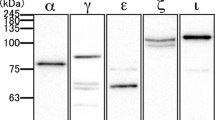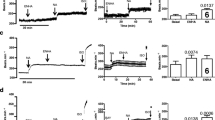Abstract
The involvement of protein phosphorylation in isoproterenol (ISO)-mediated proliferation in the rat parotid gland was investigated by labeling the cells with [32P] orthophosphate. An increased (4–6 fold) incorporation of the radiolabel was noted in the total parotid gland homogenates of ISO-treated animals when compared to controls. Plasma membrane, nuclear membrane and cytoplasm were isolated, the proteins separated by SDS/PAGE and the phosphoproteins detected by autoradiography. Two phosphoproteins with apparent Mr of 45 and 170 kDa were identified in the cytoplasm while the 170 kDa phosphoprotein also appeared as part of plasma membrane. Transfer of these proteins to nitrocellulose followed by Western blot detection with an antiphosphotyrosine monoclonal antibody showed reactivity with the 170 kDa region of the plasma membrane and cytoplasm. Separate in vitro studies involving incubations of rat parotid slices with 0.2 mM ISO and [3H] myo-inositol for 1 min induced inositol phosphate hydrolysis resulting in a significant increase in inositol-bis and -tris phosphate production. Inositol phosphate production can be blocked by pre-incubation with a mixed β-adrenergic receptor antagonist but not with physiological concentrations of α- or β1-specific adrenergic receptor antagonists, indicating the ISO effects are mediated through the β2-adrenergic receptors. The inclusion of calmodulin antagonists along with ISO prevented the expression of cell-surface galactosyltransferase and retarded gland hypertrophy and hyperplasia. These results suggest that ISO treatment leads to the phosphorylation of target proteins which may be involved in signal transduction pathways leading to cell proliferation.
Similar content being viewed by others
Abbreviations
- InsP1, InsP2, InSP3 :
-
inositol mono-, bis-, and tris-phosphates
- UDP:
-
Uridine diphosphate
- PMSF:
-
phenylmethylsulfonylfluoride
- SDS:
-
sodium dodecyl sulfate
- TFP:
-
Trifluoperazine
- P-tyr:
-
phosphotyrosine
- Gal Tase:
-
galactosyltransferase
References
Bollag GE, Roth RA, Beaudoin J, Mochly-Rosen D, Koshland DE Jr: Protein kinase C directly phosphorylates the insulin receptor in vitro and reduces its protein tyrosine kinase activity. Proc Natl Acad Sci USA 83: 5822–5824, 1986
Leeb-Lundburg LMF, Cotecchia S, Lomasney JW, DeBernardis JF, Lefkowitz RJ, Caron MG: Phorbol esters promote α1-adrenergic receptor phosphorylation and receptor uncoupling from inositol phospholipid metabolism. Proc Natl Acad Sci USA 82: 5651–5655, 1985
Schlender KK, Wei SH, Villar-Palasi C: UDP-glucose: glycogen α-4-glucosyltransferase I kinase activity of purified muscle protein kinase: cyclic nucleotide specificity. Biochim Biophys Acta 191:272–278, 1969
Pontremoli S, Melloni E, Michetti M, Sparatore B, Salamino F, Sacco O, Horecker BL: Phosphorylation by protein kinase C of a 20 kDa cytoskeletal polypeptide enhances its susceptibility to digestion by calpain. Proc Natl Acad Sci USA 84: 398–401, 1987
Woodgett JR, Gould KL, Hunter T: Substrate specificity of protein kinase C: Use of synthetic peptides corresponding to physiological sites as probes for substrate recognition requirements. Eur J Biochem 161: 177–184, 1986
Quissell DO, Deisher LM, Barzen KA: The rate-determining step in cAMP-mediated exocytosis in the rat parotid and submandibular glands appears to involve analogous 26-kDa integral membrane phosphoproteins. Proc Natl Acad Sci USA 82: 3237–3241, 1985
Kikkawa U, Nishizuka Y: The role of protein kinase C in transmembrane signalling. Ann Rev Cell Biol 2: 149–178, 1986
Soling H-D, Fest W, Schmidt T, Esselmann H, Bachmann V: Signal transmission in exocrine cells is associated with rapid activity changes of acyltransferases and diacylglycerol kinase due to reversible protein phosphorylation. J Biol Chem 264: 10643–10648, 1989
Humphreys-Beher MG, Schneyer CA, Kidd VJ, Marchase RB: Isorpoterenol-mediated parotid gland hypertrophy is inhibited by effectors of 4β-galactosyltransferase. J Biol Chem 262: 11706–11713, 1987
Humphreys-Beher MG, Schneyer CA: Cell surface of 4β-galactosyltransferase accompanies rat parotid gland hypertrophy induced by changes in diet. Biochem J 246: 387–391, 1987
Humphreys-Beher MG: Restoration of α-lactalbumin-inhibited rat parotid salivary gland hypertrophy and hyperplasia by agents specific for membrane glycoprotein N-acetylglucosamine. Archs Oral Biol 34: 811–819, 1989
Marchase RB, Kidd VJ, Rivera AA, Humphreys-Beher MG: Cell surface expression of 4β-galactosyltransferase accompanies rat parotid acinar cell transition to growth. J Cell Biochem 36: 453–464, 1988
Humphreys-Beher MG, Zelles T, Maeda N, Purushotham KR, Cassisi N, Schneyer CA: Cell surface galactosyltransferase acts as a modulator of rat and human acinar cell proliferation. Adv Dent Res Res 4: 45–60, 1990
Dowd FJ, Watson EL, Horio B, Lau Y-S, Park K: Phosphorylation of rabbit parotid microsomal protein occurs only with β-adrenergic stimulation. Biochem Biophys Res Comm 101: 281–288, 1981
Uno I, Fukami K, Kato H, Takenawa T, Ishikawa T: Essential role for phosphatidylinositol 4,5-bisphosphate in yeast cell proliferation. Nature 333: 188–190, 1989
Rillema JA: Possible role of phospholipase C in the regulation of cell division in normal and neoplastic cells. Med Hypothesis 29: 1–4, 1989
Horn VJ, Baum BJ, Ambudkar IS: β-adrenergic receptor stimulation induces inositol trisphosphate production and Ca2+ mobilization in rat parotid acinar cells. J Biol Chem 263: 12454–12460, 1988
Henriksson R: β1- and β2-adrenoceptor agonists have different effects on rat parotid acinar cells. Am J Physiol 242: G481-G485, 1982
Comoglio PM, Di Renzo MF, Gaudino G: Protein tyrosine kinases associated with human malignancies. Ann NY Acad Sci 511: 256–261, 1987
Arvan P, Castle D: Plasma membrane of the rat parotid gland: Preparation and partial characterization of a fraction containing the secretory surface. J Cell Biol 95: 8–19, 1982
Blobel G, Potter VR: Nuclei from rat liver: Isolation method that combines purity with high yield. Science 154: 1662–1665, 1966
Schaterle GR, Pollack RL: A simplified method for the quantitative assay of small amounts of protein in biologic material. Anal Biochem 51: 654–655, 1973
Pugsley AP, Schnaitman CA: Factors affecting the electrophoretic mobility of the major outer membrane proteins of Escherichia coli in polyacrylamide gels. Biochim Biophys Acta 581: 163–168, 1979
Fairbanks G, Steck TL, Wallach DE: Electrophoretic analysis of the major polypeptides of the erythrocyte membrane. Biochemistry 10: 2606–2617, 1971
Towbin H, Staehelin T, Gordon J: Electrophoretic transfer of proteins from polyacrylamide gels to nitrocellulose sheets: Procedure and some applications. Proc Natl Acad Sci USA 76: 4350–4354, 1979
Yamauchi T, Ohsako S, Deguchi T: Expression and characterization of calmodulin-dependent protein kinase II from cloned cDNAs in Chinese hamster ovary cells. J Biol Chem 264: 19108–19116, 1989
Humphreys-Beher MG, Imell M, Jentoft N, Gleason M, Carlson DM: Isolation and characterization of UDP-galactose: N-acetylglucosamine 4β-galactosyltransferase in rat parotid glands treated with isoproterenol. J Biol Chem 259: 5797–5802, 1984
Oliver C, Waters JF, Tolbert CL, Kleinman HK: Growth of exocrine cells on a reconstituted basement membrane gel. In vitro Cell Dev Biol 23: 465–473, 1987
Downes CP, Hawkins PT, Irvine RF: Inositol 1,3,4,5-tetrakisphosphate and not phosphatidylinositol 3,4-bisphosphate is the probable precursor of inositol 1,3,4-trisphosphate in agonist-stimulated parotid gland. Biochem J 238: 501–506, 1986
Hawkins PT, Stephens L, Downes CP: Rapid formation of inositol 1,3,4,5-tetrakisphosphate and inositol 1,3,4-trisphosphate in rat parotid glands may both result indirectly from receptor-stimulated release of inosito11,4,5-tris phosphate from phosphatidyl-inositol 4,5-bisphosphate. Biochem J 238: 507–516, 1986
Baum BJ, Freiberg JM, Ito H, RothA GS, Filburn CR: β-adrenergic regulation of protein phosphorylation and its relationship to exocrine secretion in dispersed rat parotid gland acinar cells. J Biol Chem 256: 9731–9736, 1981
Quissell DO, Deisher LM, Barzen KA: Role of protein phosphorylation in regulating rat submandibular mucin secretion. Am J Physiol 245: G44-G53, 1983
Soling H-D, Machado-De Domenech E, Kleineke J, Fest W: Early effects of β-adrenergic and muscarinic secretagogues on lipid and phospholipid metabolism in guinea pig parotid acinar cells. Stimulation of 2,3-sn-diacylglycerol formation by isoproterenol. J Biol Chem 262: 16786–16792, 1987
Quissell DO, Deisher LM, Barzen KA: Subcellular distribution and activation of rat submandibular cAMP-dependent protein kinase following β-adrenergic receptor stimulation. Biochim Biophys Acta 969: 28–32, 1988
Berridge MJ, Taylor CW: Inositol trisphosphate and calcium signaling. In: Cold Spring Harbor Symposia on quantitative Biology, Vol. LIII, Cold Spring Harbor Laboratory, 927–933, 1988
Berridge MJ: Inositol trisphosphate and diacylglycerol: Two interacting second messengers. Annu Rev Biochem 56: 159–193, 1987
Miyamoto A, Akino T, Ohshika H: Effects of isoproterenol pretreatment on phosphatidyl inositol turnover in rat parotid gland. Japan J Pharmacol 42: 63–70, 1986
Rhee SG, Suh P-G, Ryu S-H, Lee SY: Studies of inositol phospholipid-specific phospholipase C. Science 244: 546–550, 1989
Adams DE, Pouncey LE, Kerr W, Burrows PD, Kidd VJ: Ectopic expression of a calmodulin-regulated cell division control-related gene in certain B cell leukemias. J Cell Biol 109: Abs 25, 1989
Humphreys-Beher MG, Bunnell B, Van Tuinen P, Ledbetter DH, Kidd VJ: Molecular cloning and chromosomal localization of human 4-β-galactosyltransferase. Proc Natl Acad Sci USA 83: 8918–8922, 1986. Correction: PNAS 86: 8747,1989
Bunnell BA, Fillmore H, Gregory P, Kidd VJ: A dominant negative mutation in two proteins created by ectopic expression of an AU-rich 3′ untranslated region. Somatic Cell and Mol Genetics 16: 151–162, 1990
Ann DK, Carlson DM: The structure and organization of a proline-rich protein gene of a mouse multigene family. J Biol Chem 260: 15863–15872, 1985
Author information
Authors and Affiliations
Rights and permissions
About this article
Cite this article
Purushotham, K.R., Zelles, T. & Humphreys-Beher, M.G. Role of protein phosphorylation and inositol phospholipid turnover in rat parotid gland proliferation. Mol Cell Biochem 102, 19–33 (1991). https://doi.org/10.1007/BF00232155
Received:
Accepted:
Issue Date:
DOI: https://doi.org/10.1007/BF00232155




